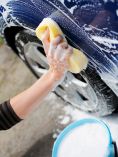It’s All in the Details: How to Detail Your Car, Inside and Out

Some people think a car is something to get you from Point A to Point B and they don’t really care how clean it is, while others take great pride in their car’s appearance—especially if it’s a brand new car. Although it’s not always feasible to wash your car at home, taking it to a car wash can be a good option. (However, when you do it yourself, you tend to do a better job.)
There is a difference between washing your car and detailing it. Think of detailing as a “deep clean” of your house. Just like keeping up on your car’s maintenance, detailing your car 2-3 times a year can help retain its resale value. Given the cost of detailing ($160 on average) doing the detailing yourself might be worth the time and effort.
What You Need
- Bucket and Sponge or Microfiber Wash Mitt
- Car Wash Soap
- Clay Bar Kit
- Wheel Cleaner
- Chamois
- Polish
- Wax
- Wax Applicator Pads
- Car Vacuum with Attachments
- Duster
- Interior Cleaner Spray
- Microfiber Cloths
- Carpet Cleaner
- Leather or Upholstery Cleaner
- Glass Cleaner
Detailing the Outside
- Choose a shady spot to wash your car.
- Mix the car wash soap and water in a clean bucket. Don’t use dishwashing liquid or laundry detergent as it can damage your car’s clear coat and wax.
- Rinse off the car using a hose that has a spray nozzle attachment to rinse away any loose dirt and grime. While it’s still wet, wash each section starting from the roof and working your way down. Re-wet a section before you wash it if it has dried before you get there and rinse each section after you finish it.
- Clean and polish exterior lights.
- Clean the tires using tire cleaner. Optional: Use tire shine. Note: Tire shine can cause dirt to stick, so you may want to forego it if you live on a dirt or gravel road.
- Clean the wheels with the wheel cleaner. Optional: Use wheel polish.
- Dry the car using a chamois or microfiber towel.
- Use the clay bar to remove additional contaminants from your car before you wax it, following the instructions on the package.
- Wax the car, following the instructions on the wax you use. Be careful not to get any wax on black plastic or rubber trim. Waxing in the spring can help protect your car’s paint from UV rays. Waxing in the fall can help protect it from salt and sand in winter weather.
Detailing the Inside
- Remove the floor mats and clean them. If they’re rubber, shake them out before washing them. If they’re carpet, vacuum them before using a carpet cleaner.
- Wipe the dash, console, door panels and steering wheel with a duster and spray it with interior cleaner spray, then wipe dry with a microfiber cloth. Be careful not to use the spray or any ammonia-based cleaners on the infotainment screen.
- Use a duster, small brush or toothbrush or cotton swabs to clean the vents and other small spots.
- Vacuum the car’s interior, including cup holders, seats and carpet, using a crevice tool on your car vac if necessary.
- Clean the inside of the windows.
- Use carpet cleaner on the carpet and upholstery cleaner on the seats. (Do this last so the carpet and seats aren’t wet when you are working on the rest of the interior.)
- If you want to deodorize your car, you can sprinkle baking soda in the carpet and letting it sit a while prior to vacuuming it. Another fun idea is to put laundry scent beads in an organza jewelry bag with a drawstring top (found in craft stores) and put them under your car seats. Note: These will melt in super-hot cars, so in the summertime you might want to skip this.
Detailing your car yourself is somewhat time consuming (allow for 2-4 hours) and requires patience and attention to detail, but it’s worth it in the end to get your car as close to showroom new looking as possible.
-
Commercial or DIY?
 Get Pros & Cons
Get Pros & ConsCommercial car wash or wash it yourself at home? There are pros and cons to each.
-
Take Care of the Inside Too
 Get Tips
Get TipsTaking care of your car’s engine is essential to keeping it running for the long haul. Here’s how to do it.
-
New Car Totaled?
 Get It Replaced
Get It ReplacedAn accident caused your brand new car to get totaled. Thankfully, Shelter personal auto policies include new car replacement.
